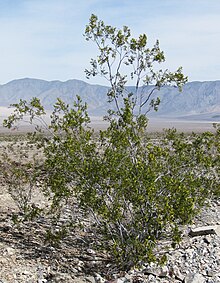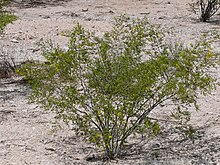Larrea tridentata
From Wikipedia, the free encyclopedia
| Larrea tridentata | |
|---|---|
 | |
| Larrea tridentata at Furnace Creek, Death Valley, California. | |
| Scientific classification | |
| Kingdom: | Plantae |
| (unranked): | Angiosperms |
| (unranked): | Eudicots |
| (unranked): | Rosids |
| Order: | Zygophyllales |
| Family: | Zygophyllaceae |
| Genus: | Larrea |
| Species: | L. tridentata |
| Binomial name | |
| Larrea tridentata (DC.) Coville[1] | |
It is a flowering plant in the family Zygophyllaceae. The specific name tridentata refers to its three-toothed leaves.
Contents
[hide]Distribution[edit]
L. tridentata is a prominent species in the Mojave, Sonoran, and Chihuahuan Deserts of western North America, and its range includes those and other regions in portions of southeastern California, Arizona, southern Nevada, southwestern Utah, New Mexico, and Texas in the United States, and northern Chihuahua and Sonora in Mexico. The species grows as far east as Zapata County, Texas, along the Rio Grande southeast of Laredo near the 99th meridian west.[5]Description[edit]

Larrea tridentata in Anza-Borrego Desert State Park
Oldest plants[edit]

King Clone, the 11,700-year-old creosote bush ring in the Mojave Desert
King Clone[edit]
Main article: King Clone
The "King Clone" creosote ring is one of the oldest living organisms on Earth. It has been alive an estimated 11,700 years, in the central Mojave Desert near present-day Lucerne Valley, California. This single clonal colony plant of L. tridentata reaches up to 67 ft (20 m) in diameter, with an average diameter of 45 ft (14 m).[8][9][10]King Clone was identified and its age estimated by Frank Vasek, a professor at the University of California, Riverside. Measurements of the plant, as well as radiocarbon dating of wood fragments, were used to determine the plant's mean annual growth rate outward from the center of the ring. By measuring the diameter of the ring, its total age could be estimated.[10][11] It is within the Creosote Rings Preserve of the Lucerne Valley and Johnson Valley.[10]
Habitat[edit]
See also: Creosote bush scrub
Creosote bush is most common on the well-drained soils of alluvial fans and flats. In parts of its range, it may cover large areas in practically pure stands, though it usually occurs in association with Ambrosia dumosa (burro bush or bur-sage).[12] Chemicals found in creosote bush roots have been shown to inhibit the growth of burro bush roots,[13] but as of 2013, much of their relationship remains unexplained.Creosote bush stands tend to display an evenly spaced distribution of plants.[14] Originally,[citation needed] it was assumed that the plant produced a water-soluble inhibitor that prevented the growth of other bushes near mature, healthy bushes. Now, however, it has been shown[citation needed] that the root systems of mature creosote plants are simply so efficient at absorbing water that fallen seeds nearby cannot accumulate enough water to germinate, effectively creating dead zones around every plant.[citation needed]
Desert adaptation[edit]
Owing to the harshness of the germination environment above mature root systems, young creosote bushes are much more susceptible to drought stress than established plants. Germination is actually quite active during wet periods, but most of the young plants die very quickly unless water conditions are optimal. Ground heat compounds the young plants' susceptibility to water stress, and ground temperatures can reach upwards of 70°C (160°F). To become established, the young plant apparently must experience a pattern of three to five years of abnormally cool and moist weather during and after germination. From this, it can be inferred that all the plants inside a stand are of equal age.Mature plants, however, can tolerate extreme drought stress. In terms of negative water potential, creosote bushes can operate fully at -50 bars of water potential and have been found living down to -120 bars, although the practical average floor is around -70 bars, where the plant's need for cellular respiration generally exceeds the level that the water-requiring process of photosynthesis can provide. Cell division can occur during these times of water stress, and new cells commonly quickly absorb water after rainfall. This rapid uptake causes branches to grow several centimeters at the end of a wet season.
Water loss is reduced by the resinous, waxy coating of the leaves, and by their small size, which prevents them from heating up above air temperature (which would increase the vapor pressure deficit between the leaf and the air, thus increasing water loss). Plants do drop some leaves heading into summer, but if all leaves are lost, the plant will not recover. Accumulation of fallen leaves, as well as other detritus caught from the passing wind, creates an ecological community specific to the creosote bush canopy, including beetles, millipedes, pocket mice, and kangaroo rats.
Uses[edit]
Native American medicinals[edit]
Native Americans in the Southwest held beliefs that it treated many maladies, including sexually transmitted diseases, tuberculosis, chicken pox, dysmenorrhea, and snakebite.[15] The shrub is still widely used as a medicine in Mexico. It contains nordihydroguaiaretic acid.[16]Herbal supplements and toxicity[edit]
L. tridentata is often referred to as chaparral when used as a herbal remedy and supplement; however, it does not grow in the synonymous plant community chaparral.[17] The United States Food and Drug Administration has issued warnings about the health hazards of ingesting chaparral or using it as an internal medicine, and discourages its use.[18] In 2005, Health Canada issued a warning to consumers to avoid using the leaves of Larrea species because of the risk of damage to the liver and kidneys.[19]The Coahuilla Indians used the plant for intestinal complaints and tuberculosis. The Pima drank a decoction of the leaves as an emetic, and applied the boiled leaves as poultices to wounds or sores.[20] Papago Indians prepared it medicinally for stiff limbs, snake bites, and menstrual cramps.[21] Guaiacum, after which the guaiacol in creosote was named, was used by native Caribbean islanders to treat tropical diseases and later for syphilis.[22][23]
Cancer Research UK states: "We don’t recommend that you take chaparral to treat or prevent any type of cancer."[24]
See also[edit]
References[edit]
- Jump up ^ "Taxon: Larrea tridentata (DC.) Coville". Taxonomy for Plants. USDA, ARS, National Genetic Resources Program. Germplasm Resources Information Network - (GRIN).
- Jump up ^ Peter Bigfoot (2011). "Chaparral". Peter Bigfoot's Useful Wild Western Plants. Retrieved 17 February 2013.
- Jump up ^ Moore, M. (1989). Medicinal Plants of the Desert and Canyon West. Santa Fe, NM: Museum of New Mexico Press. pp. 27–32. ISBN 978-0-8901-3181-7.
- Jump up ^ Felger, R. S.; Moser, M. B. (1985). People of the Desert and Sea - Ethnobotany of the Seri Indians. Tucson, AZ: University of Arizona Press. ISBN 978-0-8165-1267-6.
- Jump up ^ "Brush". The Vegetation Types of Texas. Texas Parks and Wildlife Service.
- Jump up ^ "Larrea tridentata". The Jepson Manual. Berkeley, CA: University of California. Retrieved 30 December 2011.
- Jump up ^ "Creosote Bush". US National Park Service. Retrieved 30 December 2011.
- Jump up ^ Vasek, F. C. (February 1980). "Creosote Bush: Long-Lived Clones in the Mojave Desert". American Journal of Botany. 67 (2): 246–255. doi:10.2307/2442649. JSTOR 2442649.
- Jump up ^ Weiser, M. "The oldest living thing is a quiet survivor". High Country News.
- ^ Jump up to: a b c Rodrigue, F. "Creosote Rings Preserve - Larrea tridentata - Creosote bush". Lucerne Valley Community Website. Retrieved 30 December 2011.
- Jump up ^ Schoenherr, A. A. (1995). A Natural History of California. Berkeley, CA: University of California Press. p. 14. ISBN 978-0-520-06922-0.
- Jump up ^ Marshall, K. Anna (1995). "Larrea tridentata". Fire Effects Information System. U. S. Forest Service.
- Jump up ^ Mahall, Bruce E.; Callaway, Ragan M. (February 1991). "Root communication among desert shrubs". PNAS. 88 (3): 874–876. doi:10.1073/pnas.88.3.874. PMC 50916
 . PMID 11607151.
. PMID 11607151. - Jump up ^ Phillips, Donald L.; MacMahon, James A. (March 1981). "Competition and spacing patterns in desert shrubs". Journal of Ecology. 69 (1): 97–115. doi:10.2307/2259818.
- Jump up ^ "Larrea tridentata (Sesse' and Moc. ex DC.) Coville - Creosote Bush" (PDF). US Forest Service.
- Jump up ^ Arteaga, S.; Andrade-Cetto, A.; Cardenas, R. (2005). "Larrea tridentata (Creosote Bush), an abundant plant of Mexican and US-American deserts and its metabolite nordihydroguaiaretic acid". Journal of Ethnopharmacology. 98 (3): 231–239. doi:10.1016/j.jep.2005.02.002. PMID 15814253.
- Jump up ^ Nabhan, G. P. (1993). Gathering the Desert. University of Arizona Press. p. 16. ISBN 978-0-8165-1014-6.
...health food stores have been marketing Larrea as a cure-all that they whimsically called "chaparral tea" – the plant never grows above the desert in true chaparral vegetation.
- Jump up ^ Tilford, G. L. Edible and Medicinal Plants of the West. Missoula, MT: Mountain Press Publishing. ISBN 0-87842-359-1.
- Jump up ^ "Health Canada warns consumers not to take products containing chaparral". Health Canada. 21 December 2005.
- Jump up ^ United States Herbarium 1890, p. 521
- Jump up ^ Wignall & Bowers 1993, p. 104
- Jump up ^ Foster & Johnson 2006, p. 190
- Jump up ^ Bostock & Alison 1832, p. 553
- Jump up ^ "Chaparral". Cancer Research UK. Retrieved August 11, 2013.
| Wikimedia Commons has media related to Larrea tridentata. |
External links[edit]
- "Creosote Bush". US National Park Service.
- "Larrea tridentata". Jepson Flora Project. Berkeley, CA: University of California.
- "Larrea tridentata". Dr. Duke's Phytochemical and Ethnobotanical Databases. Germplasm Resources Information Network - GRIN.
- "Larrea tridentata". Fire Effect Information System. US Forest Service.
- "King Clone, The World's Oldest Living Thing". Botanical Record-Breakers. Waynesworld.
- photo links
- "Creosote bush in desert landscape". EPA.
- "Larrea tridentata Photos". Suu.edu.



I am here to express my profound warm gratitude to the Natural Herbal Medicine, which i got from Dr hazim,after 3 days of communication he sent some herbal medicines to me. I am now leaving a healthy life since the past 5 months after the completion of my Genital and Oral Herpes treatment with the Dr hazim Natural Healing Medicine, i am now completely Herpes Free, after the application and usage of Dr hazim Medicine. Currently the only cure for Herpes, Cancer,Diabetes and every other Human diseases is Dr hazim Herbal Medicine. As i am A living witness of this great miracle, you can save more patient from pharmaceutical scandals by sharing or contacting this great Natural healer for the Medication
ReplyDeletevia email; (usmandrhazim@gmail.com) also call him or WhatsAPP on +2348154641673, Let Stop Herpes with Dr hazim Herbal Medicine. Let`s save life by sharing this on all social network as God will bless you as you share this information that will give every Herpes patient’s a hope for a new Life. Thanks for your Time..